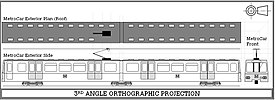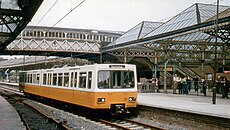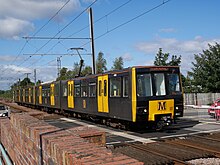Tyne and Wear Metrocar
This article needs additional citations for verification. (April 2017) |
| Tyne and Wear Metrocar | |
|---|---|
 A Metrocar, in the current black and yellow corporate livery at Meadow Well in January 2018 | |
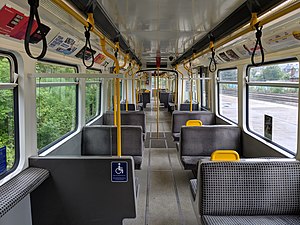 Refurbished interior of a Metrocar | |
| In service | 1980–present |
| Manufacturer | Metro-Cammell |
| Built at | Washwood Heath |
| Constructed | 1975–1981 |
| Entered service | 1980 |
| Refurbished |
|
| Number built | 90 |
| Number scrapped | 7[1] |
| Successor | Class 555 |
| Formation | Two carriages |
| Fleet numbers |
|
| Capacity | 64 seated, 188 standing |
| Operators | Tyne and Wear Metro |
| Depots | |
| Lines served | All Tyne and Wear Metro lines |
| Specifications | |
| Car body construction | Aluminium and steel |
| Car length | 4.3 SLU 27.8 m (91 ft 2 in) |
| Width | 2.65 m (8 ft 8 in) |
| Height | 3.45 m (11 ft 4 in) |
| Doors | 4 sets of air-operated double doors on each side |
| Maximum speed | 50 mph (80 km/h) |
| Weight | 40 t (39 long tons; 44 short tons) |
| Power output | 700 hp (520 kW) per unit |
| Electric system(s) | 1,500 V DC overhead lines |
| Current collector(s) | Pantograph (Brecknell Willis) |
| Multiple working | Within class |
| Track gauge | 4 ft 8+1⁄2 in (1,435 mm) standard gauge |
The Tyne and Wear Metrocars are a fleet of light rail vehicles manufactured by Metro-Cammell for the Tyne and Wear Metro in North East England between 1978 and 1981. For operation on Network Rail controlled tracks between Pelaw Junction and Sunderland, they are designated on TOPS as the British Rail Class 599.[2][3] Most were refurbished between 2010 and 2015 by Wabtec Rail at Doncaster Works and are scheduled to be replaced by Class 555 rolling stock from 2024.[4]
Design
[edit]The design of the Metrocars was partly derived from that of the German Stadtbahnwagen B. However, they were built by Metro-Cammell in Birmingham, and were not fitted with the lights and indicators that would have allowed them to run on streets.[5][6]
Each Metrocar consists of two semi-permanently connected coaches mounted on three bogies, with the middle bogie being a Jacobs Bogie. The outermost bogies are powered and the central Jacobs Bogie, located in the articulated section between both halves, is unpowered. The trains make use of rheostatic braking between 80 and 30 km/h (50 and 19 mph), with air-operated disc brakes for use during the final stages of deceleration below 30 km/h (19 mph). All bogies are also equipped with a pair of emergency magnetic track brakes, which can be used to bring a train to a complete stand in as little as 150 m (492 ft) from the maximum service speed of 80 km/h (50 mph). Metrocars have three acceleration steps, and four braking steps, and an additional emergency brake step which drops the emergency magnetic track brakes.
Many features of the Metrocar are operated by compressed air which is stored in a reservoir under the driving cab at the front of the train. Features operated by air include: air-operated disk brakes, horn, windscreen wipers and passenger doors, as well as being used to raise the pantograph. As the section between Pelaw and Sunderland on which they operate is part of the Network Rail system, the units were allocated TOPS class 599 in January 2002.[7]
Prototypes and test track
[edit]Prior to opening, two prototypes, 4001 and 4002, underwent several years of testing from June 1975 on a 1.5-mile (2.4 km) test track in Backworth.[8][9] The track was built on the route of an old mineral wagonway formerly part of the North Tyneside Steam Railway. It had a two-lane car shed and a mock station platform, along with a short tunnel section which consisted of concrete tunnel segments laid at ground level;[10] the tunnel was later demolished to allow testing of prototype cars for the Hong Kong MTR, also built by Metro-Cammell, since these cars have a very large profile. The test track was closed in 1980, and it is now home to the Stephenson Railway Museum.[10]
The prototype cars are very similar to the production fleet, with the exception of having Kiekert passenger doors, which were refitted to match the specification of the production fleet before entering passenger service. The prototype cars were also fitted with two different types of block coupling equipment (one at each end), allowing the two designs to be thoroughly tested. The prototypes featured small cabs and central end doors similar to London Underground stock, to allow evacuation of trains in a tunnel. In the event, the Metro tunnels were constructed with continuous sidewalks, making the end doors unnecessary. Prior to their entry into service in 1987, the two prototypes were refitted to reflect the specification of the production fleet.[11][page needed] The small cabs remained in the series vehicles with a passenger seat beside offering a forward view.
Livery
[edit]The Metro fleet was initially painted in a two-tone livery of cadmium yellow and white that matched the Metro station design and the livery of the Tyne and Wear bus fleet until 1986.
In 1995, a new colour scheme was introduced - solid red, green or blue with a yellow wedge at each end and yellow triangles on the doors.[12] This scheme was modified slightly in 2005 to comply with safety regulations, changing the doors to a solid yellow in order to comply with the Disability Discrimination Act 1995. During this period, a large number of special liveries were carried in addition to the standard colour scheme. These were often advertisements for local businesses such as Metrocar 4042 advertising the Evening Chronicle and Metrocar 4054 advertising Metroland. To celebrate the Golden Jubilee of Elizabeth II in 2002, unit 4032 was temporarily decorated in a special gold livery; it was then returned to the red and yellow livery, which it carried until refurbishment.
Between 2012 and 2015, 86 Metrocars were refurbished and repainted in a black and yellow livery.[13] Until 2017, prototype unit 4001 carried its original cadmium-and-white livery whilst 4002 carried an advertisement for the Tyne and Wear Metro website. Both were repainted in 2017 into the same black and yellow livery carried by the refurbished Metrocars, but in September 2019, Metrocar 4001 underwent further repainting into a 40 Years livery with all four previous liveries amalgamated into one.[14]
Electrics
[edit]The network is electrified with a 1,500 V DC overhead line system.[15] This voltage was previously used on a number of railways in the United Kingdom, including the Woodhead line, but is now unique. Each Metrocar has its own Brecknell Willis pantograph for collecting power from the overhead line. The sections of Metro owned by Nexus have a maximum speed of 80 km/h (50 mph) in some areas, which matches the top speed of the rolling stock. The vehicles have a minimum curve radius of 50 m (160 ft), although there are no curves this tight except for the non-passenger chord between Manors and West Jesmond.[16]
Formation
[edit]During the early years of Metro, units were operated in single and double sets. As single units became overcrowded, Nexus resumed using two units as standard.[17] Single units again became common during construction of the Sunderland extension when some units were taken for testing of the new track. During original construction, the Metro system was designed to use three unit sets,[15] and some platforms were constructed to accommodate this; however, due to a lack of funding, this was not possible. As a result, the units run in sets of two.
Announcements
[edit]This section possibly contains original research. (July 2024) |
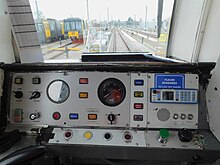
The "stand clear of the doors please" announcement, which was played before the doors started closing, was introduced in 1991. In order to increase the clarity of the announcement (especially for individuals not fluent in English) the phrase was replaced with "doors closing" in 2004.
In 2011, the "doors closing" recording was replaced in post-refurbishment Metrocars with a simple beeping noise, similar to that used on London Underground trains. The train makes a solid three-second beeping tone when the doors are released, and a rapid three-second beeping tone immediately before the doors close, in line with the 2010 UK Rail Vehicle Accessibility Regulations (RVAR). When the automated next station announcements were introduced they featured a female announcer, however during late 2014 this was replaced with a male announcer. The female announcements are still in use by two Metrocars, however can only be heard when the Metrocar is at the front of the train.
Refurbishment
[edit]All 90 units underwent a half life refurbishment between 1996 and 2000.[18] In June 2010, Wabtec Rail was awarded a contract to perform a three-quarter life refurbishment at Doncaster Works, which included making them compliant with the Disability Discrimination Act 1995.[19][20] The first was completed in February 2012, with the last in July 2015.[21][22] Cost overruns and technical issues resulted in only 86 being completed, with 4001, 4002, 4040 and 4083 remaining in service in un-refurbished condition. Because they did not comply with the Disability Discrimination Act 1995, they were restricted to operating peak hour services.[18]

The refurbishment saw the trains undergo corrosion correction work, to repair damage as a result of the trains' steel and aluminium construction, new seating, flooring and interior finish, in addition to improved saloon and emergency lighting. A new larger wheelchair space has also been created at the end of each car, featuring a "call for assistance" device. Other minor modifications include improved door seals, more concise interior signage and removal of the green boarding lamps to facilitate new audio warning equipment for door operation. Some Metrocars also featured air conditioning boxes at their A end to control the conditions within the drivers cab, these were later removed from the units due to overhead line (OHLE) clearance issues if trains were to be placed on wheelskates. Passenger counters were integrated above doors to help Nexus analyse trends in passenger levels. These features were removed from the specification midway through the refurbishment however.
After an accident at Gosforth in March 2017, 4022 was taken to Bristol Barton Hill TMD for assessment, before moving to the Nemesis Rail facility at Burton upon Trent in October 2019 for scrapping.[14]
Replacement
[edit]In January 2020, Stadler Rail was awarded a contract to build 42 (later increased to 46) five-carriage Class 555 articulated light rail trains to replace the Metrocars, with deliveries scheduled to commence in late 2022.[23][24][25][26] This was part of a £362M programme which included a new depot.[27]
After receiving feedback from 23,000 people, Nexus added an additional 12 tip-up seats, handrails in the wheelchair areas, brighter markings and changes to the interior design of the trains.[28][29] The first of the Stadler trains entered service in December 2024.[30]
Preservation
[edit]In March 2023, it was announced that 4001 would be preserved at the Stephenson Railway Museum in North Shields, on the site of the original Metro test track.[31] A second unit is to go to Beamish Museum.[4] A plan to donate a number of units to the community was abandoned due to the expected cost.[4]
References
[edit]- ^ Pritchard, Robert (July 2024). "More Metro cars scrapped". Light Rail News. Today's Railways UK. No. 269. p. 18.
- ^ "RVAR exemption application" (PDF). GOV.UK. 13 July 2022. Archived (PDF) from the original on 13 July 2022. Retrieved 13 July 2022.
- ^ "Metro EMU" (PDF). Stadler Rail. 13 July 2022. Archived (PDF) from the original on 13 July 2022. Retrieved 13 July 2022.
- ^ a b c Holland, Daniel (16 October 2023). "Metro trains set for scrapyard as bosses ditch plans to donate old carriages". Chronicle Live. Retrieved 16 October 2023.
- ^ "Metro trains celebrate 40 years of service". Nexus. 8 June 2015. Archived from the original on 9 November 2015.
- ^ "Tyneside Report 8: Part 1: Rolling stock". Modern Tramway & Light Rail Transit: 160–156. May 1980.
- ^ "Metrocars reach Sunderland". Rail Magazine. No. 429. 20 February 2002. p. 20.
- ^ "Backworth will be Tyne and Wear proving ground". Railway Gazette International. No. March 1976. p. 82.
- ^ "How Metro was built". Nexus. Retrieved 4 September 2019.
- ^ a b Young, Alan (22 May 2017). "Tyne and Wear Metro Test Track". Disused Stations. Archived from the original on 30 September 2020. Retrieved 4 September 2019.
- ^ Pickering, Graeme (August 2020). "Tyne & Wear Metro at 40 part one". The Railway Magazine. No. 1433.
- ^ "New colours on Tyneside". Rail Magazine. No. 252. 10 May 1995. p. 11.
- ^ "Tyne and Wear Metro goes grey". Rail Magazine. No. 681. 19 October 2011. p. 15.
- ^ a b "Livery marks 40 years of T&W Metro". The Railway Magazine. No. 1432. July 2020. p. 58.
- ^ a b "Tyne & Wear Metro Rapid Transit System, United Kingdom - Railway Technology".
- ^ Hunt, Michael (26 October 2022). "Metro Gradient Profile/Station Elevations - a Freedom of Information request to Tyne and Wear Passenger Transport Executive - WhatDoTheyKnow". WhatDoTheyKnow.com. Nexus. Retrieved 22 January 2023.
- ^ "May 2002 Sunderland Extension". Railway Technology. Archived from the original on 11 June 2017. Retrieved 20 February 2007.
- ^ a b "Rail Vehicle Accessibility: Exemption application" (PDF). Department for Transport. Archived (PDF) from the original on 24 July 2019.
- ^ "Wabtec to refurbish Tyne and Wear Metro trains". International Railway Journal. 10 June 2010.
- ^ "Metrocar takes to road as £20m refurbishment begins". Nexus. 22 June 2010. Archived from the original on 22 February 2015.
- ^ "New Tyne and Wear Metrocar takes to the tracks". BBC News. 15 February 2012. Archived from the original on 11 July 2023. Retrieved 1 February 2020.
- ^ "Refurbished Metrocar re-enters traffc". Rail Magazine. No. 691. 7 March 2012. p. 19.
- ^ "Tyne and Wear Metro: Swiss firm Stadler to build new fleet". BBC News. 28 January 2020. Archived from the original on 28 January 2020. Retrieved 28 January 2020.
- ^ "Stadler wins Tyne and Wear Metro fleet contract". Rail Journal. 28 January 2020. Archived from the original on 31 January 2020.
- ^ "Stadler to build Tyne and Wear metro fleet". Railway Gazette. 28 January 2020. Archived from the original on 28 January 2020.
- ^ "Rail in the 2020 budget". Railway Gazette. 12 March 2020. Archived from the original on 21 March 2020.
- ^ "Metro's new train fleet". Nexus. 6 May 2024. Archived from the original on 3 October 2022. Retrieved 6 May 2024.
- ^ "Inside our new Metro trains". Nexus. 6 May 2024. Retrieved 6 May 2024.
- ^ Holden, Alan (1 July 2021). "Tyne & Wear Metro unveils final interior design of new trains". RailAdvent. Retrieved 6 May 2024.
- ^ "Metro's first new train enters customer service". Nexus. 18 December 2024. Retrieved 23 January 2025.
- ^ "First Tyne and Wear Metro car to become museum exhibit". BBC News. 9 March 2023. Archived from the original on 9 March 2023. Retrieved 9 March 2023.
External links
[edit]![]() Media related to Metrocar (Tyne and Wear Metro) at Wikimedia Commons
Media related to Metrocar (Tyne and Wear Metro) at Wikimedia Commons

